For Lee Jae-sun, the last half century has been a struggle with granite. Hard and densely grained, granite is a challenge for any stonemason, but is also the most widely used material in Korea’s historic stone structures. The first master stonemason to be included on the list of Korea’s National Intangible Cultural Heritage, Lee has restored numerous historic stone monuments while creating his own works.
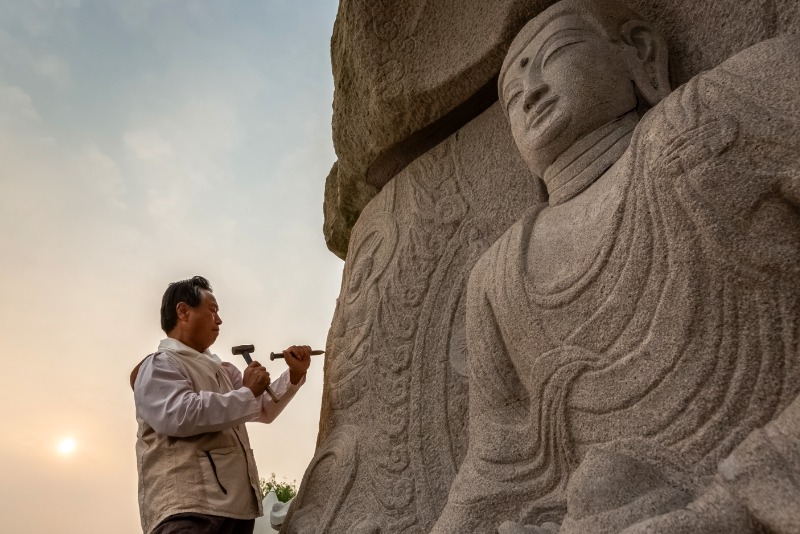
Lee Jae-sun keeps working with chisels and hammers even when traditional stonemasonry has largely been supplanted by more efficient techniques using modern machinery and equipment. He was the first master stonemason to be named a title holder when stonemasonry was included on Korea’s list of National Intangible Cultural Heritage in 2007.
In a stone yard filled with numerous carvings at various stages of completion in Guri, Gyeonggi Province, a gigantic statue of Maitreya looms over the entrance. Scattered all around are many other images of Buddhas, lions, pagodas and tomb steles, each displaying the masterful skills of Lee Jae-sun.
Born in Damyang, South Jeolla Province, Lee began working with stone when he was 13, helping his uncle and older brother, both stonemasons. As a child, he was quick-witted and loved to make his own tops and sleds, so he picked up the skills at the workshop faster than others. His basic training was done under his uncle, who traveled around the country restoring and reconstructing historic buildings and monuments.
Great Teachers
Lee was born with the aptitude but was also fortunate to find great teachers. In 1970, he went to learn from famous stonemason Kim Bu-gwan in Seoul. Two years later, he started his professional career under the guidance of Kim Jin-yeong, a renowned stone sculptor. Lee learned not only the skills required of an artisan but also the right attitude, as well as how to develop an eye for the best works.
Still, Lee was young and went off the rails for a while. Eventually, he was dismissed from the workshop for a minor mistake. He had no place to go and nothing to do. One day, for no particular reason, he headed for Seokguram Grotto in Gyeongju, where he would have a life-changing moment of enlightenment.
“I was overwhelmed by the absolute beauty of the stonework inside the cave temple. It was a wonder humans could build such a structure, and I wanted to create a masterpiece like that before I died,” Lee said.
When he returned to the workshop, he trained harder than ever. “My teacher socialized with scholars in many fields, like architecture, religion, art history and interior design, and he would take me along. Listening to their conversations, I broadened my knowledge of Buddhist art and our culture in general,” he recalled.
At age 21, Lee won a gold medal at the 1977 WorldSkills Competition held in the Netherlands. He soon started to gain fame by winning awards in a series of domestic contests. In 1989, he was designated as a master stonemason, and in 2005, as a holder of Gyeonggi Province’s Intangible Cultural Heritage in stonemasonry. In 2007, when stonemasonry was finally included in the National Intangible Cultural Heritage system, he was named the first title holder, which meant he had reached the top of his trade.
Lee works mostly with granite, which is the stone most widely distributed throughout the Korean peninsula. Hard and glossy, granite is a good building material but is very difficult to carve because of its dense grain and low absorbency. Ancient Korean stone craft began making remarkable progress in the fourth century, during the Three Kingdoms period, with active production of Buddhist statues, pagodas and bridges. Granite was one of the major materials used in the construction of Buddhist temples and royal palaces, as well as fortresses built in preparation for war. These structures have survived frequent wars, testaments to the technology and artistry of ancient stonemasons.
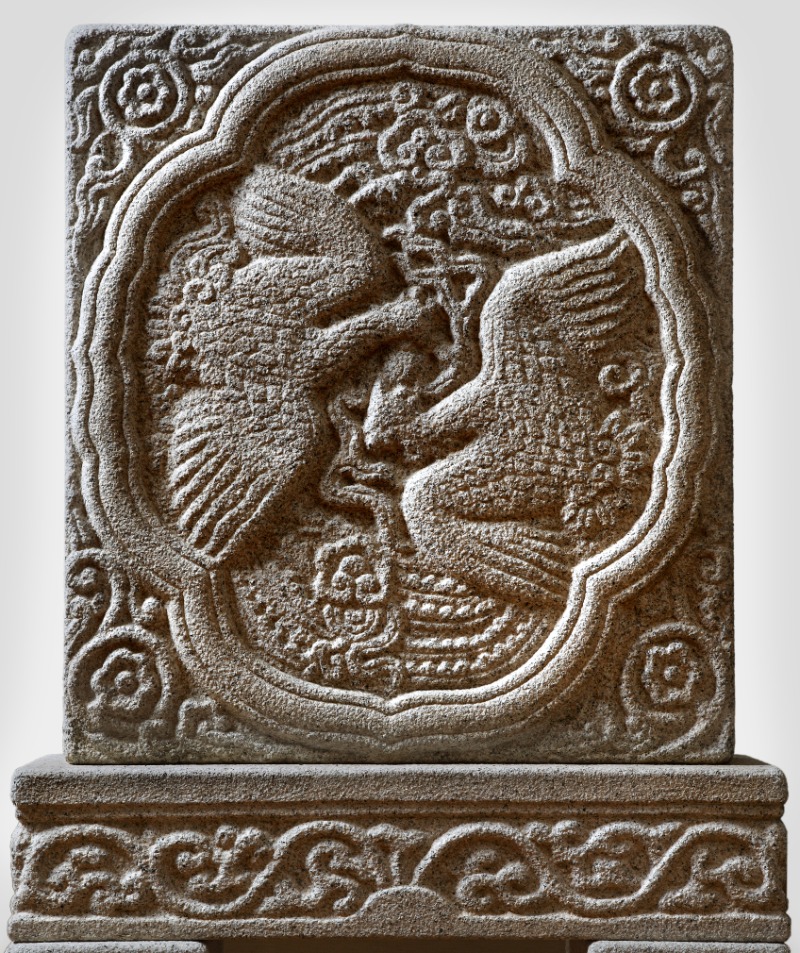
“Stone Pagoda Panel with Twin Phoenixes.” Granite. 82 × 27 × 98 cm (WDH).A pair of phoenixes and clouds are carved inside the quatrefoil, while the base and four corners are decorated with an elaborate scroll design. The phoenix is a mythical bird believed to appear with the advent of a sage who would bring peace to the world. Revered as a sacred animal, it was depicted on palace structures and the clothing and accessories of the royal family
© Seo Heun-kang
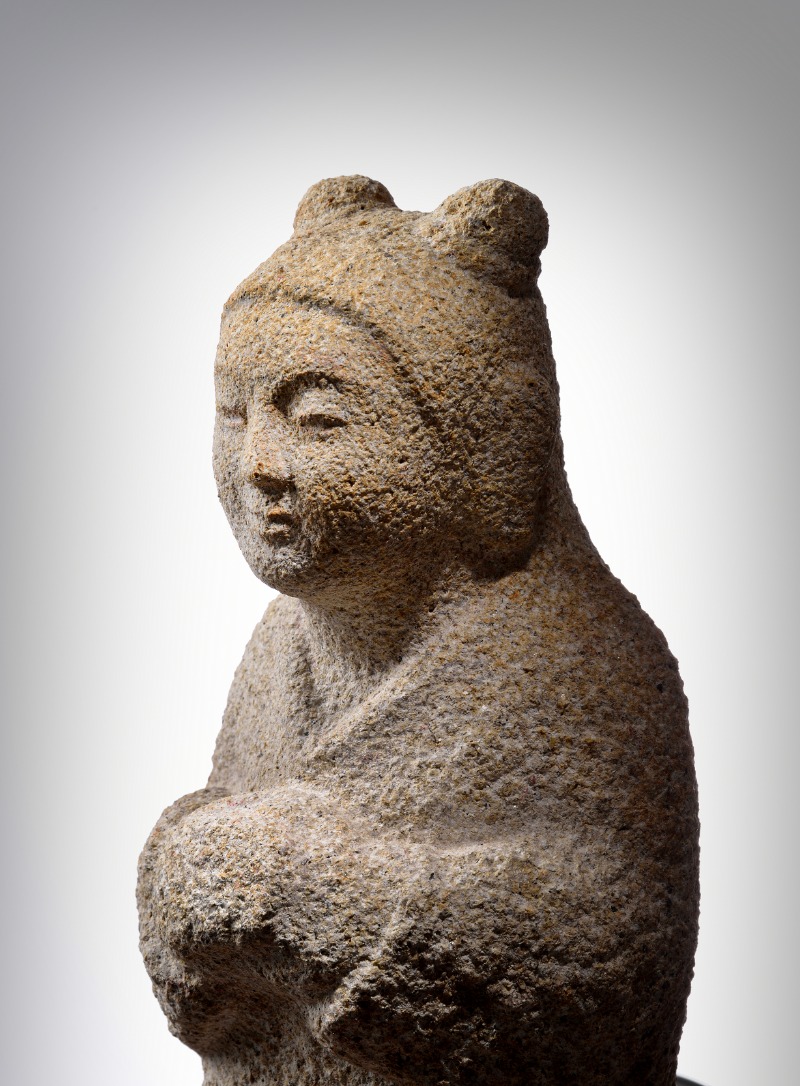
“Attendant Child.” Granite. 23 × 20 × 50 cm (WDH).The young girl represents the pristine world of Buddhism. Most statues of an attendant child have the hair done up in two buns on top of the head, or in a long braid hanging from the nape.
© Seo Heun-kang
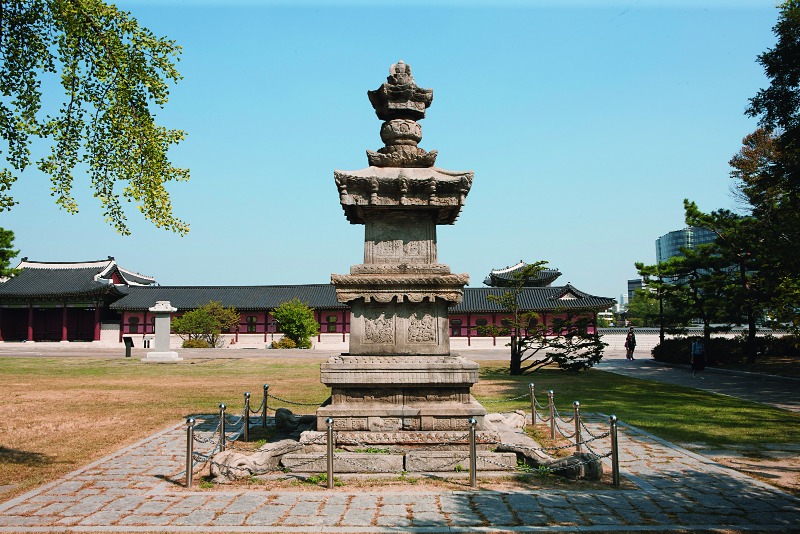
Before it was restored, this beautiful pagoda dedicated to State Preceptor Jigwang (984-1067) of the Goryeo Dynasty stood on the grounds of Gyeongbok Palace in Seoul. Originally from Beopcheon Temple Site in Wonju, Gangwon Province, it was taken to Japan during the Japanese colonial period and later returned to the palace. The pagoda was seriously damaged in an air raid during the Korean War, and was restored in 1957. Another round of restoration began at the National Research Institute of Cultural Heritage in 2016 and was completed earlier this year.
© Cultural Heritage Conservation Science Center at the National Research Institute of Cultural Heritage
Gravitating to Granite
Of the numerous cultural heritage restoration projects he has worked on so far, Lee cited the pagoda for State Preceptor Jigwang as the most challenging. “This pagoda was reborn earlier this year after major restoration,” he said, adding that it was the most arduous job, making him wonder if any stone relic could possibly be harder to restore.
The pagoda enshrines the sarira (bead-like objects found among the cremated remains of Buddhist spiritual masters) of State Preceptor Jigwang of the Goryeo Dynasty, also known as Monk Haerin (984-1067). A beautiful pagoda that deviates structurally from the style of the previous era, it is covered with elaborate carvings of clouds and peonies, bodhisattvas and celestial maidens. During Japanese rule, the pagoda was moved to the courtyard of Gyeongbok Palace from Beopcheon Temple Site in Wonju, Gangwon Province, and was subsequently shattered into innumerable pieces by an air raid during the Korean War. In 1957, after the war ended, the pagoda was reassembled by fixing each piece in place with cement mortar. But due to the lack of expertise in cultural heritage repair in those days, the structure seriously deteriorated over time, with old mortar falling off the body.
“Almost half of the broken pieces in the roof, where the damage was most serious, were replaced with new stones, each cut, carved and squeezed into the space from which a damaged piece had been taken out,” Lee explained. “It was a painstaking job, which took a year and a half to finish for me and my two students who had completed training.”
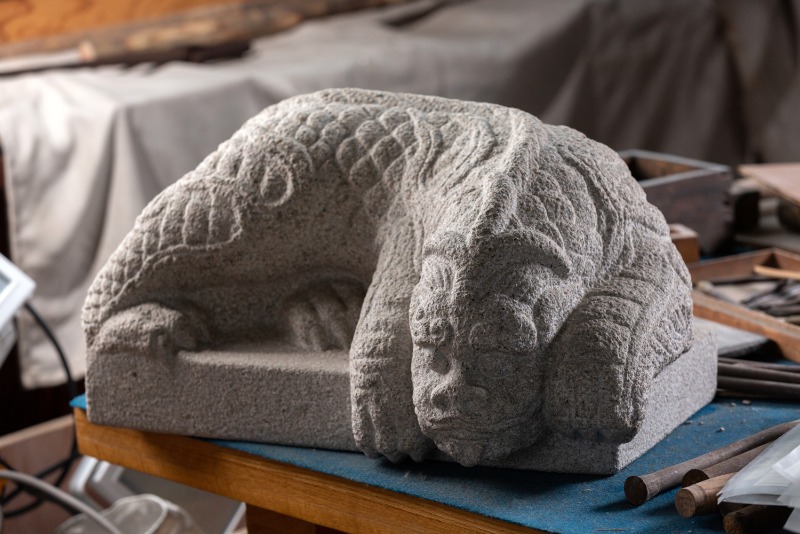
“Heavenly Deer.” Granite. 33 × 27 × 55 cm (WDH).A sacred mythical animal believed to drive off evil spirits, the heavenly deer, or cheonnok, was often carved on stone structures decorating royal palaces. For example, it can be found on Yeongje Bridge at Gyeongbok Palace. This image sculpted by Lee Jae-sun features a mane and scales expressed in dynamic curves.
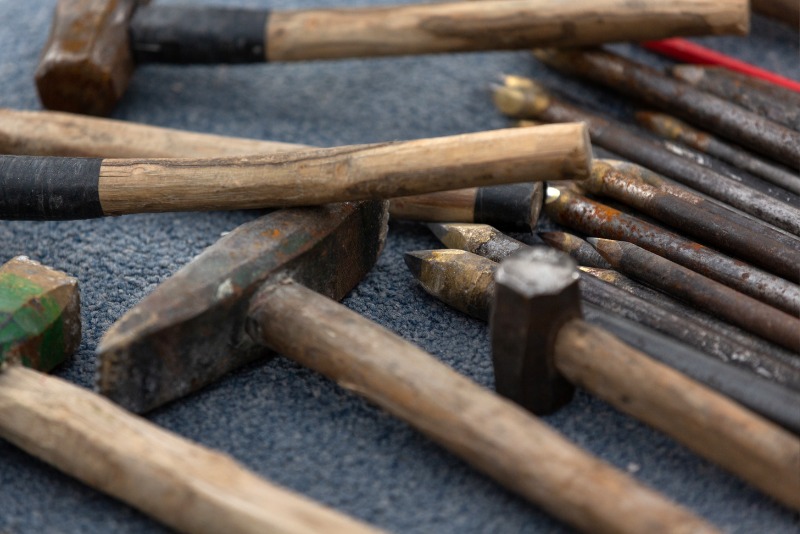
Lee Jae-sun’s varied hand tools, including a chisel for collecting and trimming rocks, a mallet for breaking them, a wedge used to pull rocks apart, and bush hammers for texturizing stone.
Restoration and Recreation
Lee has been on site at nearly every major cultural heritage restoration project in the country in the modern era, including Sungnyemun, the south gate of the old city of Seoul that was burned down in 2008, and the stone pagoda at Mireuk Temple Site in Iksan. He has taken part in the restoration of almost 2,000 stone structures in palaces and temples nationwide. He has also made replicas of famous Buddhist images and pagodas, including the Stone Seated Bodhisattva at Woljeong Temple in Pyeongchang and the stone pagoda for State Preceptor Wongong at Geodon Temple Site in Wonju. Additionally, Lee repaired and reproduced the Bukgwan Victory Monument. The stele was first erected in 1709, in Gilju, Hamgyong Province (in North Korea) at the initiative of the local people, who sought to commemorate the victorious battle waged by the righteous army raised in the province during the Japanese invasions in the late 16th century. In 1905, Japanese colonizers illegally carried the stele to their country and left it neglected on the grounds of the Yasukuni Shrine until the early 2000s.
“When the monument was in Japan, the base and the roof stone were missing, with just a large natural rock placed on top of the body,” Lee said. “Yu Hong-june, then head of the Cultural Heritage Administration, asked me to build the roof stone and base in preparation for the monument’s return. As a stonemason, what more could I have wished for?”
However, the Japanese authorities kept delaying the return, claiming that they needed approval from North Korea since it belonged there in the first place. They likely assumed North Korea would not allow it to be brought to the South.
“Mr. Yu came up with an excellent idea,” Lee said. “He persuaded North Korea to ask Japan to return the stele to the South, with a guarantee that it would be sent to the North after staying in Seoul for just a few months. The North agreed and Japan had no choice but to comply.” The stele was finally brought back to Korea in 2005. In Seoul, it was showcased at the National Museum of Korea and then at Gyeongbok Palace before being sent to North Korea the following year, along with the roof stone and base that Lee had made. Erected once again in its original location, the stele was designated as a national treasure of North Korea. Lee also made a life-size replica of the stele that now stands on the grounds of Gyeongbok Place – in front of the National Palace Museum.
While working on the reconstruction of Sungnyemun, Lee suffered from skin disorders and bronchial trouble caused by the toxic chemicals released by the burned materials. Even so, he carried on with the conviction that he was helping to write a new history after a great disaster. “I was able to trace the work of ancient stonemasons, which revealed their wisdom, and I learned a lot in the process. I saw that they had applied a feature on the stone surface to drain rainwater. While dismantling the gate structure, I verified with my own eyes those things that I’d only heard about before,” Lee said.
The most memorable project in his career, Lee said, is the statue of Amitabha sculpted in 1995 to be enshrined at the Cihang Memorial Hall in Taipei. The temple is dedicated to Cihang, a great Buddhist master whose body was mummified after he passed away sitting upright in meditation. When the Taiwanese Buddhist devotees were planning a statue for the temple, they looked at a series of stone Buddhas in other countries. Deciding that the Sakyamuni Buddha in Seokguram Grotto was “the best,” they commissioned Lee for the project.
“I was asked to create a Buddha statue similar to the one in Seokguram, and I ended up making a huge image 1.7 times the size,” Lee said. “It was sent by ship to Taiwan, and I heard that on the day it was carried to the site, when the Amitabha Buddha was seated facing west, the clouds parted and light shone all around. Watching a video of that day a while later, I was amazed by the twilight shrouding the statue. So many people looked so moved that it left a deep impression in my memory.”
“Stone doesn’t lie. If you tap at it casually, a casual cut is made, and if you strike it angrily, your anger shows on the stone’s surface. This honesty is what makes stone attractive.”
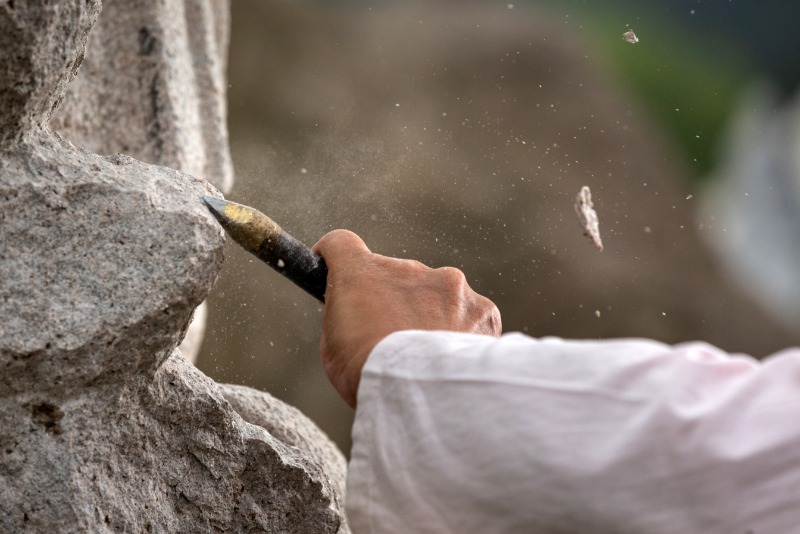
Granite is the most widely distributed stone in Korea, making up more than 90 percent of total rock reserves. Granite is hard, glossy, and has a subtle color, but is also densely grained and difficult to carve. Traditional stone sculptures and structures are therefore defined by lines rather than delicate details – soft lines flowing on the natural, roughly textured surface.
Constant Routine
Over the decades, it has been Lee’s unchanging daily routine to go to his stone yard upon waking in the morning. Cutting and carving stone all day from 8 a.m. to 6 p.m., his whole bodyaches. Nevertheless, his love for and awe of stone is immutable.
“Stone doesn’t lie,” Lee remarked. “If you tap at it casually, a casual cut is made, and if you strike it angrily, your anger shows on the stone’s surface. This honesty is what makes stone attractive.”
His skills and legacy will be inherited by his son, Lee Baek-hyeon. “We should create an environment where young people are encouraged to work in traditional crafts to preserve our cultural heritage,” he said.